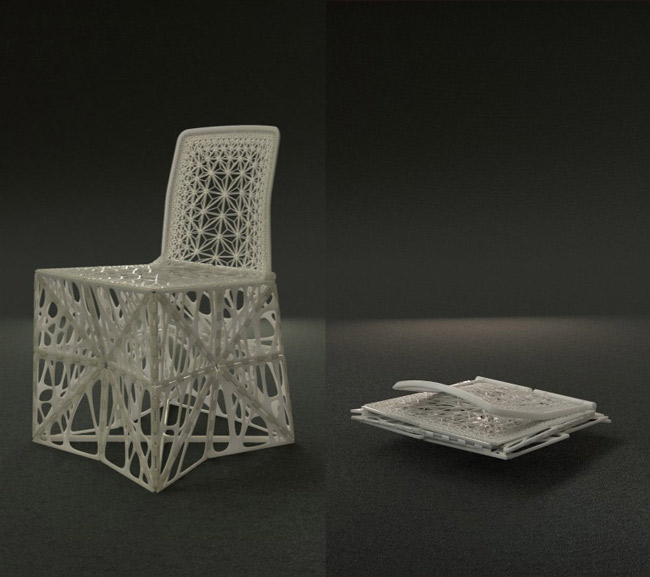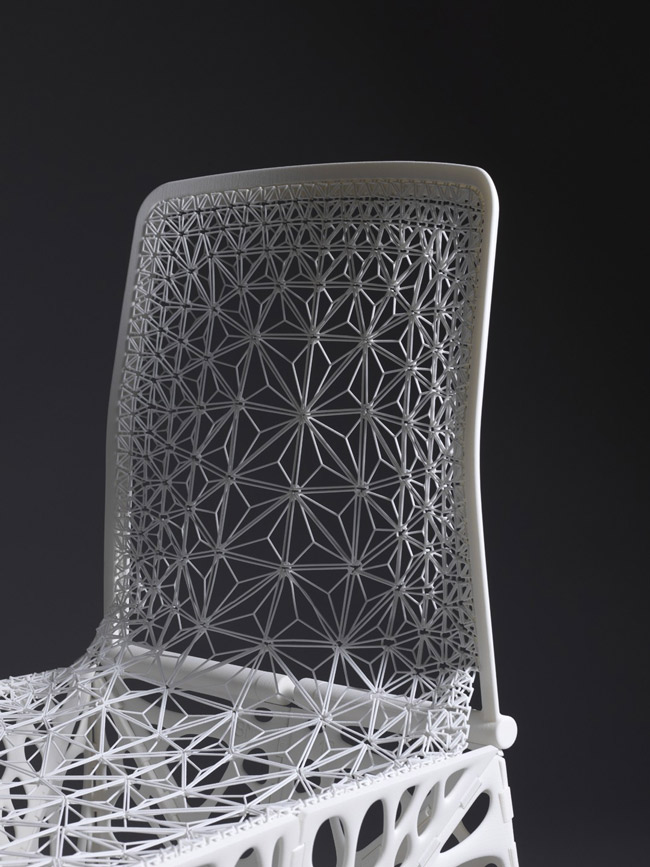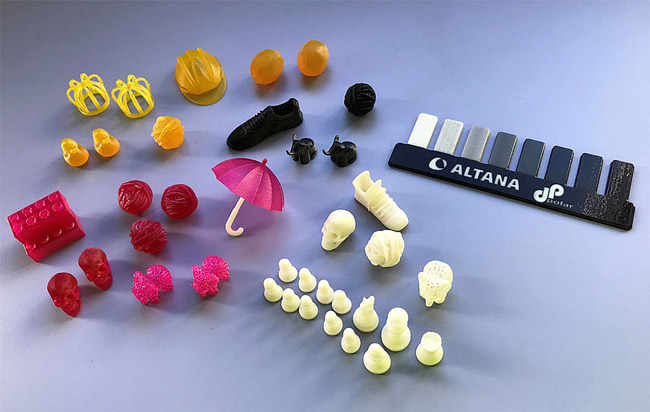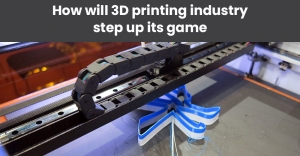Search
Textile Printing
3D Printing Ceramics
Glass and ceramic 3D printers have always been complex machines, recently AIM3D has launched its newest generation of multimaterial printheads for its composite extrusion modeling (CEM), capable of printing Plastic, metal and ceramics. CEM combines the metal injection molding process (MIM), a well-known method, with the process technologies from additive manufacturing.
The result is a very simple process that is based on cost-effective and easily available injection molding pellets and offers the freedom of 3D printing. The CEM process not only reduces material costs significantly, but also machine costs. Already known problems in production, such as residual stresses, are significantly reduced in the CEM process.

The ExAM 255 can print prototypes made of metals, such as steel, ceramics and also plastics – and all this without the need of expensive retrofitting. (aim3d.de)
CEM-E2 extruder. Capable of printing metal, plastic, and ceramics, the extruder’s print heads are optimized for different materials and are designed to achieve improved accuracy, higher surface quality, and better mechanical properties of parts. AIM3D has also developed its own ceramic Pellets, in combination with the CEM extruder this makes possible for the making of 3D printed ceramic parts.

Ceramic pellets contain small particles of ceramic bounded by plastic, such plastic is later dissolved or removed. (aim3d.de)
The process of how this pellets become a final 3D printed part are described bellow:

In the CEM process, only the plastic component of the Ceramic pellets is melted. The ceramic powder bound by the plastic is layed out to form the desired 3D print, which is still quite fragile. (aim3d.de)

In the next stage of the process, the plastic is first debinded, that means the binder is chemically or thermally dissolved. Finally, the temperature is raised in a sintering furnace to just below the melting point of the ceramic. The particles bond on a molecular level and form a stable ceramic part. (aim3d.de)

Due to the process, the sintered part shrinks. This shrinkage is mostly homogeneous in all three-dimensions and depends on the printing material. The sintering shrinkage can be taken into account by a simple scaling of the printing geometry depending on the material. (aim3d.de)
3D printing Ceramic is not an easy task. Most of the existing methods rely on high temperature to help reach the ceramics melting point to later mold it into the desired form, but laying particles of it in the desired form to later fuse them together is a much more efficient and controlled method.
3D Printing Décor
3D printing has opened a whole new range of possibilities in numerous directions, including interior design and decor. Several designers have experimented and adopted this technology, several online communities exist around this topic, meaning you can now 3D print your own furnish and decorate your home or office with DIY objects.
With 3D printing you can do more than just furnish your house, you can create the mood and bring magic to any setting. You can infuse your home with your own unique personality, with 3D printed décor accessories going from the functional to the peculiar.
Speaker Systems
Additive manufacturing has several advantages, one of them is the variety of materials that can be used, some materials require new techniques, even some unconventional materials can be used to create functional and artistic design. Acoustic-wise, having the ability to mold and design a resonating chamber can exploit several complex advantages over traditional manufacturing methods.
DEEPTIME, a Czech design studio specializing in audio products, has 3D printed the first commercially available audio set, the speakers are made from sand.

The Spirula Speaker is the world's first speaker 3D printed with sand, made in a limited production run of 1618 pairs. (deeptime.limited)

DEEPTIME developed a 3D printing method that turns sand, pigments and resins into airtight and resonance-free forms. This allows the sound system to have a great finishing quality and a audiophile grade audio experience. (deeptime.limited)
Binder jetting 3D printing technology allowed DEEPTIME to design and manufacture speaker enclosures with virtually no limits of complexity and variability of the shapes or sizes. This enabled the speaker to generate promising acoustic qualities, aimed towards demanding audiophiles.

The unique design of the speaker system is quite exquisite piece worthy of a décor specialist (deeptime.limited)
Furniture
The Tamu chair is created by designer Patrick Jouin. The prototype was unveiled earlier 2019 at Milan Design Week, the design is said to be inspired by nature and aims use as little material as possible. Jouin is a passionate designer and for the past 15 years, he and his agency have been exploring the uses of 3D printing in several décor collections, specially furniture.
Tamu is a foldable chair which takes up less space and the least amount of material possible to make. (patrickjouin.com)
Despite its unconventional 3D printed structure, this chair is even more impressive through the fact that it’s foldable and takes up surprisingly little space when in its most compact form which also allows it to be portable. Its hinged panels can fold into one another and allow the chair to pack flat. It all makes for a strange and wonderful combination, what Jouin describes as, “a little bit of magic, and the realization that we can use less space and material as possible to design a sustainable world,” given that a perfectly 3D-printed chair should have zero waste by definition.

The Tamu chair is made with polyamide, consisting of 48 hours of 3D printing and 1647 pieces composing the final product. (patrickjouin.com)
Dassault Systèmes is supporting Patrick Jouin in his approach and contributing its resources through the 3D Experience collaborative platform, to rise to a new challenge.
Whether you are a professional 3D printing hobbyist or a Designer, the ability to 3D print your own décor objects is an opportunity to explore your imagination limits. One thing is clear, there is literally no home decor that cannot be printed. You only need to find the right printer for the job.
3D for direct-to-garment printing Kornit new MAX technology
When it comes to printing direct-to-garment, we’ve seen all kinds of prints and patterns printed on different types of fabrics and color schemes. Kornit recently launched the new MAX digital printing technology which delivers a high-density graphic design decoration and it can simulate embroidery, vinyl, and heat transfer in a single and waste-free process making it a revolutionary technology for the industry.

Courtesy of Kornit.
This new product is creating huge expectations into the fashion and apparel industry aiming at MAX technology is coming to expand its resources of digital on-demand textile production and not just keeping it with mainstream fabric types.
“Kornit’s new MAX capabilities bring sustainable on-demand production to the mainstream,” said Omer Kulka, Kornit Digital CMO. "We plan to roll it out to additional market segments such as team sports, athleisure, diverse categories of fashion, and home décor applications."

Courtesy of Kornit.
The Kornit Atlas MAX is available on the market now. Its industrial-scale direct-to-garment production system provides great printing quality and a wide and vivid range of colors. It is currently working with the new XDi technology for 3D printing and a new Kornit Atlas system update will be delivered during the first months of 2022.
These are some of the specs for MAX Technology according to Kornit:

Courtesy of Kornit.
Besides Kornit’s MAX, its ActiveLoad Automation technology is a new robotic system and its main purpose is to ensure continuous production and consistency without having human error, in a labour-intensive media handling for the textile industry.
“There’s a growing realization and acceptance that on-demand production is the answer to meeting the demands of today’s consumer,” added Ronen Samuel, Kornit Digital CEO.
So Kornit is basically evolving and launching innovative products for the wide-format printing market. It makes users and consumers excited to always see what else we are going to see from them in the future.


Photos courtesy of Kornit.

How will 3D printing industry step up its game
3D printing definitely has its own market and with time, people are more and more willing to invest in a printer so they can print anything at home like a regular 2D printer. Also, there are some good competitive prices out there and nowadays buying one is more accessible and cheaper than some years ago.
3D printers were really impressive since their beginning, but not everything was perfect, and 3D printed pieces had a lot of improvements in order to function well and deliver reasonable printing parts. In the present, prints have a lot to improve when it comes to quality, but the truth is that the most inconvenient issues are printing timings and that is because they are way too prolonged and some prints could even take more than 24 hours to be ready so obviously this has been one thing to keep in mind before you even consider to print something.

3D printing sample at APPPEXPO 2018 in Shanghai, FLAAR-REPORTS archive
3D printers normally start to print from the bottom of the object and they start adding a layer at a time as they prin. When objects are irregular at the top or any other area needs it, the printer and the software add support material to these parts and it can easily be removed and thrown away after the print is ready. Creating this support material makes a print to take much more time than having the printer print just the piece itself. So it is more costly and time-consuming, especially for metal or any other material besides plastic.
Luckily for us, two researchers at Penn State have created a new system that reduces the amount of support material needed on each print by having a system with five axes instead of just having the typical x, y, and z.

3D printing sample at APPPEXPO 2018 in Shanghai, FLAAR-REPORTS archive
Xinyi Xiaoa and Sanjay Joshi proposed in a paper called “Process planning for five-acid support free additive manufacturing,” using a 3D printing with a movable build plate or extrusion arm to create objects in 3D space as they are printed, therefore making each surface flat while it is been extruded.

Screenshot courtesy of Penn State University
“Using a five-axis deposition machine has the potential to build structures without the need for supports,” the researchers wrote. “However, there is a lack of automated process planning software to support the full use of five-axis machines. [We introduce] an automated method that allows reorienting the part during the build using a five-axis machine.”
The main idea is that this process could cut objects into separate pieces that must be printed on a different axis, so prints won't need support material and therefore can be produced faster. For example, in the image below the software cuts the rabbit into 4 pieces dividing it into different axis.

Screenshot courtesy of Pennsylvania State University
On the other hand, if you print the rabbit on a regular 3D printer, it probably would be completely covered by support material and some parts would have difficulty being removed entirely.

Screenshot courtesy of Instructables In-House Art
“Large metal components, using traditional additive manufacturing, can take days and waste lots of materials by using support structures,” said the creators. “Additive manufacturing is very powerful, and it can make a lot of things due to its flexibility; however, it also has its disadvantages. There is still more work to do.”
Right now there aren’t many 5-axis printers available in the market and definitely not for home printers, but imagine having to say goodbye forever to the annoying process of removing support material… I bet many people would be pleased.
Continuous 3D printing tech
3D printing is now possible using relatively small and low-cost machines, it is generally a slow process with some size limitations. This is because 3D printers require a series of steps to cure, refill, and reposition themselves for each additive cycle. Several companies have developed in the past years several methods to try and overcome this limitations, one of the methods we will show in this article is specially made to have an “infinite” axis of print size.

Back in 2017 BlackBelt released a 3D printer that combines 3 print heads with a conveyor belt system. (3dforms.co.za).
3D printers with a similar configuration as the previously shown, have max printing size limitations on X-Y axis but with the Z-axis, taking the form of a conveyor belt, allows for theoretically infinite sized horizontal parts or even a continuous production of 3D printed parts without the need for interaction of another mechanism to remove finished prints.

Possibilities with a conveyor belt configuration on the z axis. (Powerbelt3D).
Unlike regular FDM 3D printers, this setup uses tilted nozzles when printing. This configuration brings several advantages on the final print and the geometrical limitations of the 3D print, including for less support material needed in most prints, especially with more extreme overhangs that can be 3D printed, but there are some more other simpler limitations.

The new obtained infill pattern helps for rigidity on most designs, also helps reduce the layer adhesion issues generated on regular FDM printers. (Powerbelt3D).
Some limitations of this 3D printer configuration are bed adhesion, compatible filament materials (ABS is not suitable for this method), and one of the more complex is the Printing software, Conveyor belt 3D printers require special modified versions of the already available slicing software, they require several parameters modified in order to work correctly, but most of the already available conveyor belt 3D printers come with the proper documentation.
There are several 3D printers out there with a conveyor belt configuration, most recently, Creality launched their own variant, the 3DPrintMill (CR-30), a conveyor belt 3D printer with a resolution of 100 micrometers.

The CR-30 has the possibility of a roller attachment for extra-long 3D prints. (Powerbelt3D).
Blackbelt 3D has been around for a while and their conveyor belt 3D printers have great quality and support, they took 3 years to develop their first conveyor belt printer and are currently the brand with the widest and highest printing area with 340mm on each axis plus the infinite “z-axis” length.

Blackbelt also sells a roller attachment for extra-long 3D prints. (Blackbelt3D).
So, why buy a conveyor belt 3D printer?
There are several reasons why, but the main ones are the capability of serial and semi-automated production and the ability to print parts that are larger than the printer itself.
BIGREP Pro, Fast Industrial 3D Prints
Founded in Germany, 2014, BigRep’s vision is to innovate the 3D printing and manufacturing business. Opening to a new dimension of 3D printing and 3D manufacturing.
BigRep has developed machines that prints with engineering-grade materials to ensure users can manufacture the applications they need, in large scale.
BigRep printers are designed for industrial applications, BigRep developed its proprietary Metering Extruder Technology (MXT®), unlike from regular FDM (fused deposition modeling) also known as FFF, MXT is a faster and more accurate extrusion technique, this helps reduce regular FDM extrusion issues and helps to produce faster prints, thus eliminating some limitations of FFF extrusion.

MXT® technology relies on a chamber of fused filament that is later pushed by a highly accurate servo motor.
The inclusion of a Bosch Rexroth CNC Control System brings new IoT features to industrial additive manufacturing for industry 4.0 integration. With tools like remote operation, data collection, cloud-based analytics and more, the BigRep PRO ensures seamless production by enabling print quality monitoring and fleet management anytime and anywhere.
Most recently BigRep introduced a 3D printer rental service, this leasing platform is available across North America.
“For the first time, our service makes a large-format industrial 3D printer available to new customers or small- to mid-sized businesses looking for a hassle-free and flexible turnkey AM solution at an affordable rate,” says Frank Marangell, BigRep CBO and President of BigRep America. “Facing a challenging economic environment and volatile markets, customers today want quick and flexible solutions without big investments or long-term obligations. By making 3D printing available today, BigRep is helping companies stay ahead of the curve with an agile manufacturing solution to be even more competitive tomorrow.”

BigRep has a variety of 3D printers, for different industrial needs , from left to Right, BigRep Studio (special for abrasive material Industrial 3D printing), BigRep One (large format accessible Industrial 3D printer) and BigRep Pro (fast and reliable large format industrial 3D printer).
All in all, the BigRep machines are a viable option for small businesses and manufacturers looking for an industrial-grade 3D printer that is relatively affordable and has a larger build volume, especially to industries and processes where reliability and repetitive prints are a must.

BigRep studio is a large format 3D printer with a fully enclosed, temperature-controlled chamber, with a build size of 1000 x 500 x 500 (mm).
Malleable textile fibers, a new way of using textile?
Have you ever straightened your hair or at least known someone who has? Obviously, heat is in charge of making this change, but with the minimum amount of water, its effect could reverse completely or at least to have a notable change. Why does this happen? It’s really simple… Hair has shape memory and in response to some changes or stimulations, it will return to its original shape.
Imagine your clothes could do the same? For example, a T-shirt that expands when exposed to moisture and that shrinks when dry or having a one-size piece of clothing that fits all person’s measurements? Researchers at the Harvard John A. Paulson School of Engineering and Applied Sciences (SEAS) developed a biocompatible material that can be 3D printed into a predetermined shape and programable to go back to its original shape. It is made with keratin, which is extracted from Agora wool used in textile manufacturing.
One of the main characteristics, or at least one of the most important in my opinion, is the reduction of waste in the fashion industry, “The implications for the sustainability of natural resources are clear. With recycled keratin protein, we can do just as much, or more, than what has been done by shearing animals to date and, in doing so, reduce the environmental impact of the textile and fashion industry.” Said Kit Parker, the Tarr Family Professor of Bioengineering and Applied Physics at SEAS.

Keratin fiber textile. Photo courtesy of The Harvard Gazette.

Keratin fiber textile. Photo courtesy of The Harvard Gazette.
As mentioned before, when this keratin-based fiber is stretched or exposed to an external stimulus, the structure re-aligns to fit some determined shape and it remains in that position until it is triggered to go back to its original shape.
As an experiment, one fiber sheet was turned into a permanent origami shape. Once it was set, the researchers submerged it in water and they unfolded and rolled it into a tube and dried it. Once it was set again and turned into a fully stable tube, they submerged it again so the process was reversed and it folded back into an origami star.
“This two-step process of 3D printing the material and then setting its permanent shapes allows for the fabrication of really complex shapes with structural features down to the micron level,” said Cera. “This makes the material suitable for a vast range of applications from textile to tissue engineering.”
So for a little twist when it comes to textile, it sounds like a great way of innovation and this might be the future for the fashion industry for reducing its gigantic waste this industry produces.
3D Ceramic Printing Brands & Applications
We all know ceramics have been on the market for so long and they have even been a trending material for a while when it comes to 3D printing materials. Obviously when it comes to ceramics, the first thing that comes to my mind is kitchenware and pottery (even its applications have a wide variety of markets) and I bet you are surrounded by ceramics at home without even acknowledging it.
3D ceramic parts are a bit challenging and most of the time the cost increments to much. This has led companies to wander and try different and new printing techniques.
There are brands that provide 3D ceramic printing services and we are giving you a few of them for you to start your business or to provide new and different products with these techniques.
3DCeram
3DCeram is a French company with over 15 years of expertise in 3D ceramic printing. Their focus on applications is aerospace, biomedical and jewelry. The brand offers serial production services and they develop and create their own ceramic 3D printing. They believe in a “support-free” system which relies on a technology that doesn’t leave any support marks on the printing parts surface.
Kwambio
Kwambio is a company that focuses on ceramic materials. Being a New-York based brand has let them to work with different designers and artists to create different products. Its main applications are artistic, kitchenware, sculpture making, industrial products, jewelry. Their actual production is in Ukraine with their self-developed 3D printers.
Formatec
Formatec is a brand based on The Netherlands which specializes in developing and manufacturing ceramic technical components. The brand is mainly focused on ceramic injection molding (CIM) processes to produce the ceramic parts. They create high quality parts by using DLP (Digital Light Procesing) technology which also helps to create even larger volumes of products. It’s main applications are medical, dental, industrial design, aerospace parts.
In-house production Printers
Obviously outsourcing is a great idea for many applications in the ceramic printing world, but in some cases an in-house production can save you a good amount of money. So, it’s important for you to know that there are a few great options in the market if you decide to give it a try. These machines are expensive, but it’s always nice to know or even have an idea of what kinds of printers are out there.

CeraFab S Series. Photo courtesy of Lithoz.

Admaflex 300. Photo courtesy of Admatec.

X1 160Pro. Photo courtesy of Businesswire.
So, if you are interested in ceramics, you should definitely dive into the 3D printing industry and give it a try since there are more launches and there is a growing process of materials range.
dp Polar AMpolar i2- Industrial series 3D printer with XAAR printhead
The revolutionary AMpolar i2 brings several features and advantages to printing Additive Manufacturing parts on a truly industrial scale.
First introduced in Formnext 2019, the AMpolar i2’s patented Additive Manufacturing process uses an array of Xaar 1003 printheads to jet parts at volume, and at a significantly reduced cost when compared to traditional 3D printing machines.
The highly productive single-pass printing process delivers build volumes of up to 700 liters across its pioneering, continuously rotating print platform.

The printer employs the manufacturer’s proprietary technology, called High-Speed Rotative AM Process (HSR), which as its name suggests uses a one of a kind, constantly rotating print platform to create several parts at a time. (dppolar.de)
In terms of capabilities, the printer has a multi-process ability where additional automated equipment can be integrated within the printing process.

For example, it is possible to combine the rotating print platform with a fully automated pick-and-place process that will pick up parts and place it in a position as printing is resumed to complete the fixture. (dppolar.de)
The 3D printer has two different modes of production, the Manufacturing Mode and the Prototyping Mode. In the MM mode, the user will benefit from the platform’s large build volume for series production. On the other hand, in the PM mode, the focus will be to enable high speed rapid prototyping due to shorter cycle-time.

In fact, the AMpolar i2 is equipped with three individual print stations, allowing the production of multi-material parts very quickly. (dppolar.de)
The German company dp polar has partnered with ALTANA AG, a leading specialty chemicals company, to offer tailored materials for its platform.

Cubik Ink is their material suite, with each material available in transparent and various colors. (dppolar.de)

Another feature on the AMpolar i2 are the water soluble support materials that allows quick and automatic removal of all support structures. There is no need for additional chemicals or mechanical treatments. (dppolar.de)
As we covered in previous articles, the Xaar 1003 printhead combines highly accurate drop placement, consistent drop volume and high frequency jetting with variable drop size capability to deliver precise functional fluid control. This is essential for precise production patterns and surface characteristics.
Mike Seal, Xaar’s Business Development Manager, Advanced Manufacturing and 3D Printheads said; “dp polar’s use of the Xaar 1003 printhead and the innovative design of the AMpolar i2, shows the natural progression of photopolymer jetting from a prototyping technology to a true manufacturing process; a transition we are seeing more and more within functional inkjet applications”.

the Xaar 1003 printhead family is a versatile line with several use cases, including 3D printing (Xaar.com).
Mimaki 3DGD-1800, a large format 3D printer
Mimaki has just introduced their 3rd 3D printer, they first debuted the Mimaki 3DUJ-553 back in September 2017, a 10 million-color 3D printer; In contrast their new product, the Mimaki 3DGD-1800 is a large-sized/high-speed 3D printer, to be precise a machine that can print at a maximum speed of 35cm (height) per hour, this in a special UV curing resin.

This massive 3D printer is capable of producing 1.8-meter height prints (Mimaki.com).
The Mimaki 3DGD-1800 is a solution developed in association with Massivit 3D, the pioneer in large format 3D printers, the printer’s available molding area is 1.45 x 1.11 x 1.8 meters (57.1 x 43.7 x 70.9"), the printer has 2 gel dispensing extruders giving the machine the ability to print 2 different objects at the same time, basically the same specs the Massivit 1800.

This massive 3D printer is capable of producing 1.8-meter height prints (Mimaki.com).
Just like the Massivit 1800, the Mimaki 3DGD-1800 uses the Gel Dispensing Printing (GDP) technology developed by Massivit, this guarantees fast curing times and reduces the need for support material, this is done thanks to an ultraviolet photosensitive gel-type curable resin, the resin is laid out in a similar way as Fused Deposition Modeling (FDM) 3D printers do, with the difference being the material used.

The UV-curing resin is laid by the extruder while some high power UV-LED’s let it cure almost instantly (Massivit3D.com).
Mimaki first announced their latest 3D printer, the 3DGD-1800, back in march, and has made it available since April 1st 2020
In the following table you can see the complete specs of the Mimaki 3Dgd-1800:
| 3DGD-1800 | ||
3D printing method |
Gel Dispensing Printing / Dual print |
|
Printhead |
2 |
|
Nozzle size (dia.) |
1.8 / 2.6 mm (Replaceable) |
|
Max. printing size / Weight |
W1,450 × D1,110 × H1,800 mm / 150 kg |
|
Printing speed (*1) |
Height 350 mm/h |
|
Layer pitch |
Normal |
1.3 mm |
Quality |
1.0 mm |
|
High Resolution |
0.8 mm |
|
Printing material |
MG-100W (White UV curable resin) |
|
3D data format |
stl, obj, 3ds, ply, blend |
|
Slicer software |
3DGD Slicer |
|
Operating
|
Power |
3×25A、380-400VAC±10%、50/60Hz |
Air pressure |
600 to 800 kPA |
|
Power consumption |
10kW (Printing) |
|
Temperature |
16 to 30 degC. |
|
Interface |
Ethernet |
|
Dimensions (W x D x H) |
3,000 × 2,200 × 2,800 mm |
|
Weight |
2,500 kg |
|
Source: Mimaki

















